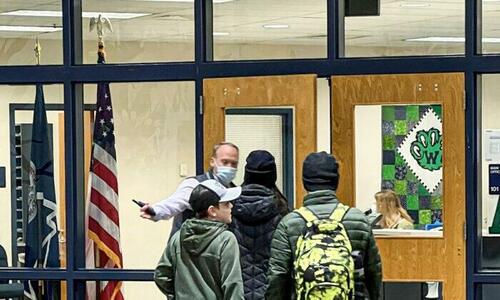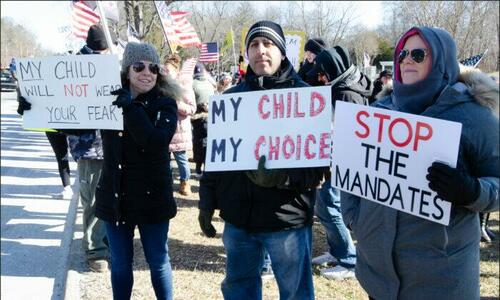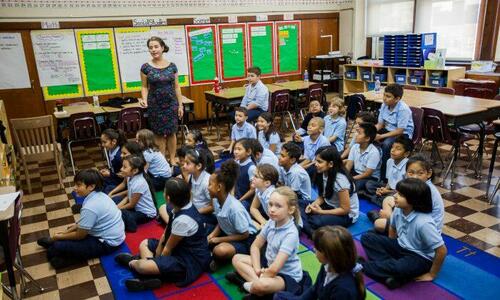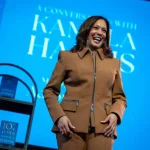
Authored by Lawrence Wilson via The Epoch Times (emphasis ours),
Over a million children left public schools in 2020, a migration that came on the heels of school lockdowns and masking requirements, and was hastened by increased parental dissatisfaction with K-12 education.

Enrollment in U.S. public schools declined by 1.4 million students between fall 2019 and fall 2020, dipping to 49.4 million, a loss of nearly 3 percent, according to data from the National Center for Education Statistics (NCES).
The decline may be closer to 2 million, according to a report by Education Next showing that traditional public school enrollment as a percentage of all school enrollment declined sharply between 2020 and 2022.
Enrollment in traditional public schools fell from 81 to 76.5 percent of total enrollment during that period, while enrollment in public charter schools, private schools, and homeschooling grew by a combined 4.5 percent.
Those numbers indicate that nearly 2 million students left traditional public schools for other educational options over the previous three years.
In many cases, the disruption in learning due to COVID-19 policies was the catalyst many parents needed to make the jump away from public schools to charter schools, private schools, and homeschooling.
Based on recent enrollment figures and the comfort many parents express with their decision to opt out of public schools, it appears the missing millions will not return.
Dissatisfaction With Learning
Parent satisfaction with K-12 education plunged between 2019 and 2022, according to GALLUP. Prior to the onset of COVID-19, 51 percent of parents said they were either completely or somewhat satisfied with their child’s education. Three years later, that satisfaction level was 42 percent, the lowest in over 20 years.

Nearly a quarter of Americans, 23 percent, said they were completely dissatisfied with their child’s education.
Parent interviews conducted by The Epoch Times revealed that distance learning during school lockdowns provided a glimpse into the classroom that made parents question their school’s ability to educate their children.
“For a while, [our kids] were getting homework assigned to them by their teachers … but there was no teaching going on,” Matt Mohler of Tallahassee, Florida, said. He moved his children from a highly public school to a classical charter school in the fall of 2020.
“Once a week they’d all get together on a classroom call, and that was the extent of what the teachers were doing. We realized that we weren’t getting a lot of effort out of the teachers.”
“The distance learning was eye-opening,” said Maria Nicholas of Whittier, California, who began homeschooling her son in the fall of 2021. She said she would not have considered homeschooling if not for the lockdown, but seeing how her middle-school son thrived while at home rather than in the classroom was a factor in her decision.
Shireen Qudosi of Orange County, California, took her autistic son out of public school in October 2020. “There wasn’t even a functioning curriculum in place, which access into the classroom through remote learning confirmed.”
Mask and Vaccine Requirements
In January 2022, 65 percent of public schools tracked by data site Burbio had student masking requirements. Parent and student protests against mandatory masking erupted that month in New York, California, and Massachusetts.
The combination of public school mask policies and state vaccine mandates drove some parents to seek alternatives.
Longtime home-schooler Christine Hamman saw an influx of parents to her home-school group during the last two years. “COVID added people who are anti-vax and anti-masking,” she said. “Mostly, parents didn’t want their kids masked for six hours a day.”
“When SB 276 was signed, we realized we’d be homeschooling all of our children,” said Sara Cruz, speaking of a California law expanding vaccine requirements for schoolchildren. Cruz began home-schooling during the current school year.
“I’m on the other end of this spectrum,” Nicholas said.
“I’m for it, and I would like more people to have it,” she said, but seeing the number of people unmasked and unvaccinated at her school caused concern for her son’s health. “I thought they weren’t doing enough to keep the kids safe,” she said, which was a factor in her choice to withdraw.

Other reasons for leaving public schools included concern over appropriate teaching on social issues like sex, gender, and drug abuse, as well as student safety.
Parents don’t want their children exposed to the “radical indoctrination that the public schools are doing,” J. Allen Weston, Executive Director of the American Home School Association, told The Epoch Times.
“The school had a ‘Say No to Drugs’ campaign, but they were going into detail on what drugs were out there,” Mohler said, speaking of his daughter’s second-grade class.
“If they’re going to learn about that, they’re going to learn about that from me.”
Other parents expressed concern over bullying, the stress created by active-shooter drills, and the availability of sexual content on smartphones carried by other students.
Where They Went
Most parents who opted out of public schools over the last few years chose other educational options for their kids. Homeschooling was the choice for many, though the number of children enrolled is difficult to estimate.
“It is impossible to know the exact numbers because more than half of the states do not require parents to register as homeschoolers. Or if they are required, then the state does not keep count,” Weston said. He reported that his organization grew by a factor of 20 over the last three years.
Heather Martinson, the founder of Celebration Education home-school co-op, told The Epoch Times the Facebook group for homeschoolers in her area tripled to 12,000 members since January 2020.
Public charter schools, which had more than doubled to 3.4 million in the preceding decade, enrolled another 270,000 students between 2019 and 2021, according to the National Association of Public Charter Schools (NAPCS).

Private school enrollment grew as well, adding over 500,000 in 2020 reach 11.1 million, according to data site Statista. A study by the CATO Institute shows that more private schools gained enrollment than lost it during 2020-21.
Some students who left public schools in 2020 entered the workforce. About 2 million students dropped out of high school that year, according to NCES.
In 2017, the NCES found that 47 percent of high school dropouts were employed. If the percentage remained similar in 2020, that would mean over 900,000 students left school for work that year.
Other Shifts
Though not reflected in national totals, public school enrollment in large cities has been in decline for up to 20 years in some cases. These losses appear to be driven more by demographic changes than by parents opting out of public schools.
Enrollment in Denver public schools dropped 3 percent from 2019 to 2021, a change driven in part by low birth rates and a shrinking population, according to education news site Chalkbeat.
New York City’s public school enrollment decreased by some 38,000 students in 2020, but 9,376 of them simply crossed the river to New Jersey according to the website Gothamist. More than 5,100 students moved from New York to Pennsylvania that year, and another 5,600 to Florida.
Also, the population of New York state was in decline during that time. The state lost over 350,000 to domestic migration between July 2020 and July 2021.
Enrollment in Los Angeles public schools has dropped 42 percent since the early 2000s, according to the online publication EdSource. LA Unified School District Superintendent Alberto Carvalho told journalists in July that recent losses are attributable partly to people moving to other states because of political ideology or the desire for lower taxes.
Return Unlikely
Relatively few students who withdrew from public school in 2020 have returned so far. Public school enrollment rebounded just 0.2 percent in 2021, including first-time enrollees, and remains at its lowest level since 2010.
Parents who made the choice to withdraw from public school during the last two years are highly satisfied with their choice, according to a report from NAPCS.
Nearly 90 percent of families who changed school types experienced a positive change as a result of the switch, with 57 percent saying their child was happier, according to NAPCS.
Read more here...
Authored by Lawrence Wilson via The Epoch Times (emphasis ours),
Over a million children left public schools in 2020, a migration that came on the heels of school lockdowns and masking requirements, and was hastened by increased parental dissatisfaction with K-12 education.

Enrollment in U.S. public schools declined by 1.4 million students between fall 2019 and fall 2020, dipping to 49.4 million, a loss of nearly 3 percent, according to data from the National Center for Education Statistics (NCES).
The decline may be closer to 2 million, according to a report by Education Next showing that traditional public school enrollment as a percentage of all school enrollment declined sharply between 2020 and 2022.
Enrollment in traditional public schools fell from 81 to 76.5 percent of total enrollment during that period, while enrollment in public charter schools, private schools, and homeschooling grew by a combined 4.5 percent.
Those numbers indicate that nearly 2 million students left traditional public schools for other educational options over the previous three years.
In many cases, the disruption in learning due to COVID-19 policies was the catalyst many parents needed to make the jump away from public schools to charter schools, private schools, and homeschooling.
Based on recent enrollment figures and the comfort many parents express with their decision to opt out of public schools, it appears the missing millions will not return.
Dissatisfaction With Learning
Parent satisfaction with K-12 education plunged between 2019 and 2022, according to GALLUP. Prior to the onset of COVID-19, 51 percent of parents said they were either completely or somewhat satisfied with their child’s education. Three years later, that satisfaction level was 42 percent, the lowest in over 20 years.

Nearly a quarter of Americans, 23 percent, said they were completely dissatisfied with their child’s education.
Parent interviews conducted by The Epoch Times revealed that distance learning during school lockdowns provided a glimpse into the classroom that made parents question their school’s ability to educate their children.
“For a while, [our kids] were getting homework assigned to them by their teachers … but there was no teaching going on,” Matt Mohler of Tallahassee, Florida, said. He moved his children from a highly public school to a classical charter school in the fall of 2020.
“Once a week they’d all get together on a classroom call, and that was the extent of what the teachers were doing. We realized that we weren’t getting a lot of effort out of the teachers.”
“The distance learning was eye-opening,” said Maria Nicholas of Whittier, California, who began homeschooling her son in the fall of 2021. She said she would not have considered homeschooling if not for the lockdown, but seeing how her middle-school son thrived while at home rather than in the classroom was a factor in her decision.
Shireen Qudosi of Orange County, California, took her autistic son out of public school in October 2020. “There wasn’t even a functioning curriculum in place, which access into the classroom through remote learning confirmed.”
Mask and Vaccine Requirements
In January 2022, 65 percent of public schools tracked by data site Burbio had student masking requirements. Parent and student protests against mandatory masking erupted that month in New York, California, and Massachusetts.
The combination of public school mask policies and state vaccine mandates drove some parents to seek alternatives.
Longtime home-schooler Christine Hamman saw an influx of parents to her home-school group during the last two years. “COVID added people who are anti-vax and anti-masking,” she said. “Mostly, parents didn’t want their kids masked for six hours a day.”
“When SB 276 was signed, we realized we’d be homeschooling all of our children,” said Sara Cruz, speaking of a California law expanding vaccine requirements for schoolchildren. Cruz began home-schooling during the current school year.
“I’m on the other end of this spectrum,” Nicholas said.
“I’m for it, and I would like more people to have it,” she said, but seeing the number of people unmasked and unvaccinated at her school caused concern for her son’s health. “I thought they weren’t doing enough to keep the kids safe,” she said, which was a factor in her choice to withdraw.

Other reasons for leaving public schools included concern over appropriate teaching on social issues like sex, gender, and drug abuse, as well as student safety.
Parents don’t want their children exposed to the “radical indoctrination that the public schools are doing,” J. Allen Weston, Executive Director of the American Home School Association, told The Epoch Times.
“The school had a ‘Say No to Drugs’ campaign, but they were going into detail on what drugs were out there,” Mohler said, speaking of his daughter’s second-grade class.
“If they’re going to learn about that, they’re going to learn about that from me.”
Other parents expressed concern over bullying, the stress created by active-shooter drills, and the availability of sexual content on smartphones carried by other students.
Where They Went
Most parents who opted out of public schools over the last few years chose other educational options for their kids. Homeschooling was the choice for many, though the number of children enrolled is difficult to estimate.
“It is impossible to know the exact numbers because more than half of the states do not require parents to register as homeschoolers. Or if they are required, then the state does not keep count,” Weston said. He reported that his organization grew by a factor of 20 over the last three years.
Heather Martinson, the founder of Celebration Education home-school co-op, told The Epoch Times the Facebook group for homeschoolers in her area tripled to 12,000 members since January 2020.
Public charter schools, which had more than doubled to 3.4 million in the preceding decade, enrolled another 270,000 students between 2019 and 2021, according to the National Association of Public Charter Schools (NAPCS).

Private school enrollment grew as well, adding over 500,000 in 2020 reach 11.1 million, according to data site Statista. A study by the CATO Institute shows that more private schools gained enrollment than lost it during 2020-21.
Some students who left public schools in 2020 entered the workforce. About 2 million students dropped out of high school that year, according to NCES.
In 2017, the NCES found that 47 percent of high school dropouts were employed. If the percentage remained similar in 2020, that would mean over 900,000 students left school for work that year.
Other Shifts
Though not reflected in national totals, public school enrollment in large cities has been in decline for up to 20 years in some cases. These losses appear to be driven more by demographic changes than by parents opting out of public schools.
Enrollment in Denver public schools dropped 3 percent from 2019 to 2021, a change driven in part by low birth rates and a shrinking population, according to education news site Chalkbeat.
New York City’s public school enrollment decreased by some 38,000 students in 2020, but 9,376 of them simply crossed the river to New Jersey according to the website Gothamist. More than 5,100 students moved from New York to Pennsylvania that year, and another 5,600 to Florida.
Also, the population of New York state was in decline during that time. The state lost over 350,000 to domestic migration between July 2020 and July 2021.
Enrollment in Los Angeles public schools has dropped 42 percent since the early 2000s, according to the online publication EdSource. LA Unified School District Superintendent Alberto Carvalho told journalists in July that recent losses are attributable partly to people moving to other states because of political ideology or the desire for lower taxes.
Return Unlikely
Relatively few students who withdrew from public school in 2020 have returned so far. Public school enrollment rebounded just 0.2 percent in 2021, including first-time enrollees, and remains at its lowest level since 2010.
Parents who made the choice to withdraw from public school during the last two years are highly satisfied with their choice, according to a report from NAPCS.
Nearly 90 percent of families who changed school types experienced a positive change as a result of the switch, with 57 percent saying their child was happier, according to NAPCS.
Read more here…
Loading…





